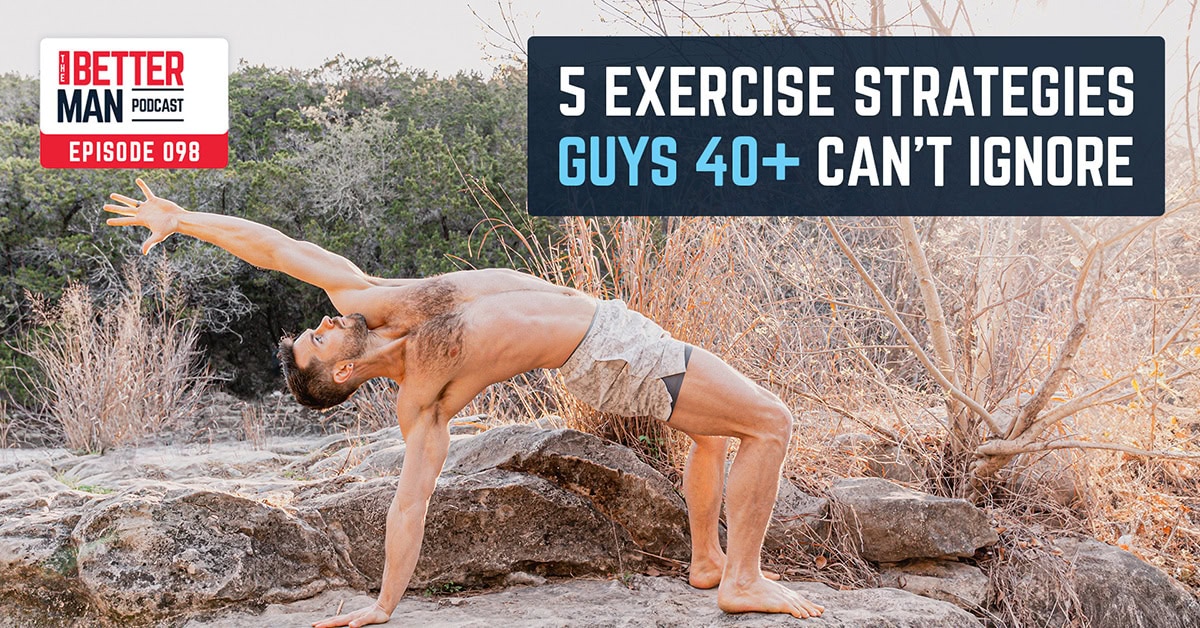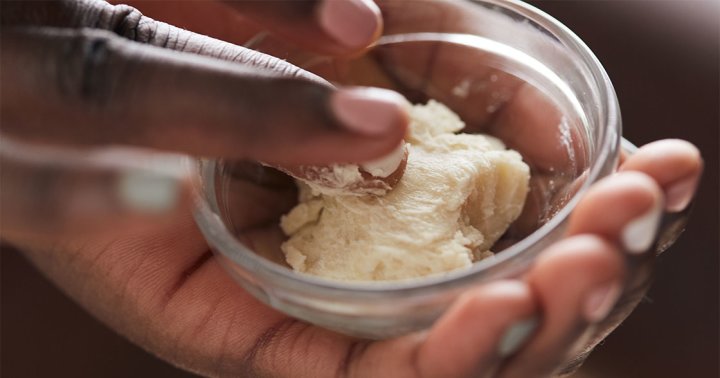5 Exercise Strategies Guys 40+ CAN’T Ignore | Dean Pohlman | Better Man Podcast Ep. 098
Here’s a harsh truth: Getting old sucks. It’s easier to get hurt. You feel more sore more often. Little aches and pain become more pronounced and harder to ignore. But worst of all: You can’t workout like you used...

Episode 098: 5 Exercise Strategies Guys 40+ CAN'T Ignore - Dean Pohlman - Transcript
Hey guys it’s Dean. Welcome to the Betterment Podcast. Today’s episode is a solo episode. I’m going to be giving you my top five strategies for how to approach your fitness as you get older. So these are changes that we need to implement as we get older. If we want to be able to continue to exercise, to stay relatively pain free, and to make sure that we are minimizing our risk of preventable injury, things like muscle tears, things like muscle strains, overuse injuries, things that happen with exercise, but, but are preventable as long as we are following, I won’t say preventable entirely, but we can we can drastically mitigate the risk of these overuse injuries and these muscle tears if we are using some common sense strategies. Now, the reality is that a lot of you guys have been exercising for decades and decades. And, you know, suddenly we get into our 40s or 50s or 60s and we can’t keep getting away with what used to work. So maybe you didn’t used to stretch in the past.
Maybe you didn’t do any yoga or flexibility work. Maybe you’ve never done any sort of recovery exercise or when you exercise, it’s all high intensity exercise. There’s never been any sort of lower or medium intensity exercise, and all of that are things. Those are all things that you used to be able to get away with. But those are things that you can’t get away with anymore.
So here’s a few realities of, of what happens as we get older. And, as a friend of mine just said last week, getting old sucks, but it’s a reality we can’t ignore, so it’s easier to get hurt straight up. It’s just easier to get hurt. There’s longer warmup required and on that, easier to get hurt. Note a lot of these injuries aren’t even things that are exercise related.
It’s getting in and out of the exercise sometimes. it could be taking a shower. It’s maybe experiences when you turn around to look behind you and you turn too fast, or you reach down and pick something up too quickly, or you, you push yourself just a little bit too far. And these little annoying injuries happen. But you know, if they happen, we can’t ignore them.
Second thing longer up required. So maybe you didn’t have a comprehensive warmup in the past. Maybe you got away with that. Maybe your idea of a warmup is just doing some lighter weight version of the exercises you’re going to be doing. That’s not going to cut it anymore. You need to do, a more effective warmup, and I’m going to talk through that later on.
You also need to do more recovery work. So again, you might not have done much recovery work in the past. Maybe you don’t need to stretch to to foam roll to take some time to, to skip a scheduled workout and do some recovery work instead. But you need to spend more time on that. The general rule of thumb here is for, all the intense exercises that you do, you have to do an equal amount of recovery time.
So if you do 30 minutes at the gym, you should probably do 30 minutes of recovery stretching as well. Other change, those little aches and pains that you used to be able to ignore turn into bigger problems that you cannot ignore. So this is a really, common theme. Maybe you used to have a little bit of shoulder pain when you did, you know, bench press.
Maybe you used to have a little bit of knee pain when you did squats, but now that hurts a lot more than it used to. And it’s getting to the point where you’re actually having to skip workouts entirely, or you’re just avoiding certain exercises entirely. You don’t have to to continue to ignore those exercises. You just have to do the appropriate flexibility, mobility work in the appropriate exercises to address the dysfunction that’s causing that pain.
You just need to work on strength in a way that you haven’t before. Soreness becomes more significant. Here’s another point. it takes longer for your muscles to recover. You have to put more effort into recovery and that soreness just feels a lot more significant than you used to. So there are a lot of people who say, oh, I’m sore today, so I’ll skip the workout.
And that’s not, that’s sometimes we do need to skip the workout. But if your barometer of whether or not you work out is if you’re sore or not, then you’re definitely missing too many workouts. You’re going to be sore. It’s a reality. you do the appropriate warmup, you do the appropriate flexibility work. You listen to your body.
but soreness doesn’t mean that you skip your workout entirely. Energy and motivation get lower. There’s a lot of reasons for this. part of this is just the aging process. We’re we’re more tired than we used to be. We need more energy. We’ve also got more stress going on in our life. We have more responsibilities. A lot of us have families.
a lot of the things that we’ve ignored for our entire lives, a lot of the the traumas, the stresses of life, the things that we push down instead of dealing with those drain a lot more energy than they did before. The longer you avoid those things, the longer you avoid dealing with stresses, the more stress they cause.
They literally weigh you down and suck your energy. So I think that’s also a big consideration in the energy. The motivation is lower component. And the last thing I want to say here is that change is hard no matter how old you are. but everybody says that it’s harder as you get older, so change is hard no matter what.
no matter what age you are. But once we have our established patterns, once we have our established habits, it’s hard to change those. So, you know, if you’re struggling with the idea of getting older, if you’re struggling with, you know, having to change the way you exercise, it sucks, but you’ve got to do it.
It’s tough. It’s not fun. But, if we want to be able to continue to exercise, to feel good, to have, to live life without pain, got to make those changes. So we do have to change our approach to exercise, into consideration of all these things. So I’ve got five things in particular that I recommend.
and these are the things that I think, are most important. And these are the big mistakes that I think that most guys make, middle age and older guys make when it comes to exercise. for you guys, you know, just to kind of empathize with your situation. A lot of guys that I talk with, our athletic when they were younger, maybe they participated in high school sports, maybe they didn’t.
but you know, as you go into your 20s and 30s, spend a lot of time working, spend a lot less time exercising, and we can get away with that for, you know, a few years. Yes. Back pain sucks, but apparently we’ve accepted as a society that back pain is okay. So talking about back pain with all your other friends are like, oh, okay, it’s normal.
back pain is not normal. It should not be normal. It is a sign of dysfunction. And there is, a reality where you can live with that back pain. You just have to do the right exercises on a consistent basis. and of course, we do that with Mantle yoga, and then we get a little bit older.
Maybe you get into your 40s or 50s or 60s and you realize that all that inactivity has added a significant amount of, of, of weight. And you’re like, okay, now I’m overweight. Now I really need to do something about this. And so you get back into exercise, you do it the way that you’re used to doing it, and suddenly you’re injured a lot more quickly.
You’re not able to exercise the way that you used to. And so that’s why we need to change up the way that we exercise. So there are five strategies here. The first one is warmup. So guys we need to be warming up more effectively with our workouts. The other consideration why warmup is so important is because a lot of us are inactive during the day.
We’re not moving at all. And then suddenly we’re going into a workout and we’re expecting your body to perform at, you know, the maximum level. And that’s not a good way to lead into a workout. So the warm up here is really, really important. And a good warmup is, and this is something that, I think I’m really, really good at is creating warm ups.
And we’ve got all sorts of warm ups in the members area. There are a few few of them are free on the Mantle Yoga YouTube channel. If you’re not a member and you want to check those out, but a good warm up includes a combination of mobility, work of muscle activation, and isometrics. So the mobility work is going to get you into extended range of motion, ideally getting you into whatever range of motion you’re going to be using when you are doing your workouts or sometimes your your warm ups will differ based on what the workout is.
And then we also want to make sure that we’re doing a significant amount of muscle activation work as well. We need to get those muscles that are generally dormant or inactive during the day. We’ve got to get those muscles turned on. And and for most of us, the muscles that we aren’t using during the day are the most important muscles in your workout.
That’s going to be your glutes. That’s going to be the hips. That’s going to be your core, that’s going to be your upper back muscles. And if we don’t integrate that muscle activation into the workout, what’s going to happen is you’re going to rely on the muscles that you were using during the day while you’re sitting in a chair.
So you’re going to be able to use your arms, you’re going to be able to use your quads, but you’re not using anything else. You’re using your lower back instead of your core. You’re using your quads and your knees instead of your hip muscles. you’re using only the front of your torso, your chest, instead of your upper back.
So there’s just a lot of, really, significant imbalances that will lead to pain and eventually injury if we don’t do the warm up to kind of undo what we were not doing or what we did during the day. So, an effective warmup should take can take ten minutes if you really want to. You really want to maximize the efficiency of your workout.
The longer your warmup goes, to a certain point, the more effective your workout will be. So I’ve got some so that I do that are 20 minutes long. But after I do that, I go straight into my workout and I crush it entirely and everything feels great. I don’t have knee pain. I don’t have back pain the day afterwards.
You’re going to feel less soreness because you’re not contributing to those imbalances that cause pain. So getting a good warmup is definitely worth the time. And I would I would take the time for the warm up out of the main workout. If you’re having to choose between a warm up and your main workout, take a few reps or take a few sets off whatever your main workout is and put that into your warmup.
your body is going to thank you for that. So that’s a that’s strategy. Number one is an effective warmup strategy. Number two recovery work. So as we get older muscles take longer to recover. there are as a result of this, you’re going to have a higher risk of overuse injuries. So this is what happens when you do too much exercise and you don’t give your muscles enough time to recover.
So we need to do more recovery work. recovery work can look like doing a restorative yoga routine. So a lot of, more passive focused or less intense, mobility work. It can also be foam rolling, mobility work using mobility tools. It could just be, you know, sitting on the ground and going through various stretches while you’re watching TV could be getting a massage.
Lighter exercise is also a form of recovery work. So I would call this active recovery work. But just getting your body moving, flushing out lactic acid right. That feeling of soreness. So going on a walk, doing some lighter resistance training, doing some stuff with bands, not focusing on the muscle engagement as much, but just getting in some movement.
So the lighter intensity exercises, come really, become really important as we’re getting older. We have to spend time moving our body without the purpose. without the direct goal of building strength or pushing intensity, getting your body moving, doing this recovery work. this is an indirect way to help us build strength more quickly. It’s not direct.
but it is indirect, and it is necessary in the overall process of helping you to get stronger. We just have to do that recovery work. I can’t emphasize that enough. This is something that we do really well in man for yoga. We’ve got a lot of recovery workouts. We’ve also got filters that make it easy to find recovery work, a system that works really well with, with a lot of people is just doing three days a week, or you’re doing your more intense exercise and then three days a week where you’re doing a less intense, workout.
So you’ve got your, your gym or your intense yoga days on day one, three and five. And then days two, four and six, you’re doing more, less intense exercise. and that’s a good way. That’s a good approach to try if you’re struggling with finding the right balance. Number three is strength training. So as we get older we tend to lose muscle, strength that we might have used to have been able to take for granted is no longer a guarantee.
So we might need to start doing some strength training and specific strength training in order to keep the body strong. Some of these things might be exercises that you recommend from that you recognize from physical therapy. So if you’ve ever been to physical therapy before, they have you working with bands. Maybe they have you doing, you know, some some, some basic core exercises.
maybe they’ve got you doing some shoulder, some specific isometric shoulder exercises, as is, or some, internal and external rotation with the shoulders. If you ever had an IT rotator cuff injury, you’ll know what I’m talking about. And if you haven’t had one, fun fact, 66% of men, cadavers, who were examined over the age of 64 had rotator cuff tears, partial or full.
So, men were going to experience some rotator cuff issues. Very likely. And in the span of our lives. So the strength back the strength training portion here. So we need to incorporate strength training more into our, into our weekly workout routine. That’s going to be different for different people based on what your lifestyle is. So what you spend time on during the day.
So there are some predictive factors. So like if you have a desk job then it’s a probably a given that you’re going to have to be doing some more upper back strengthening, some more pulling exercises for your upper back. We’re also going to have to do some more lunge focused exercises to get your hips open and build strength there.
We need to be doing some backbends to be able to strengthen your spine. In the opposite way as when you’re sitting. So there are some things that are and there are all, you know, there are all weighted exercises that we can do to do this. And there are also some, there are also some things that we can use with bands or fixed exercise machines.
or free weights. But the point is that you may have been able to get away with not strength training in the past, but if you are experiencing joint pain, if you are experiencing, little aches and pains, stretching might not make that go away. Stretching is good for immediate pain relief. Sometimes, but it might not under it might not address the existing cause.
A lot of people assume that if their joints hurt, that they need to stretch more. And in reality, we also need to have strength. So strengthening is something that you don’t want to overlook. And this is something that’s essential as we get older, especially if we want to preserve bone density, if we want to preserve muscle mass. that’s something that is going to help with our overall longevity.
so strength training is really important. The fourth thing here that I’ve listed is regular flexibility and mobility work. And, this is something this is a huge, huge part, of the aging process is that we lose flexibility. And so this is a conversation that I’ve had with countless guys. And, man, for yoga, but you may not have had to do any flexibility or mobility work in the past.
Maybe you’ve gone to the gym for decades. You’ve been able to lift the way that you want to. You don’t have to do mobility work. You don’t have to do recovery work. And then suddenly everything starts hurting and you’re like, what’s wrong with my body? Why can’t I keep doing this anymore? The big answer here is that you need to actually do flexibility work.
Now, there is something that happens in the body when we hit the age 50, where our flexibility just all of a sudden goes, goes to crap. So, that’s what I notice a lot, in the guys that I have conversation with is that when you hit 50, flexibility suddenly gets a lot worse. And so we need to work on that flexibility, that mobility to be able to keep the muscles lengthened so that we can do these exercises that we’re used to.
If you’re only doing strength training, you’re shortening the muscles, you’re shortening the range of motion. And by doing that you’re actually making yourself less strong. So flexibility and mobility isn’t just necessary to be able to have pain free, movement and pain free exercise, but it’s also going to help you be better and perform better at your other strength training workouts.
So this is you know what most people come to man for yoga for is for the flexibility and mobility work, especially for guys who are active. you know, there there obviously is a strength component that goes with man for yoga. And there’s a lot of people who do this, and this is the primary way that they build muscle.
but for the guys who are already working out at the gym, they’re already lifting weights and they’re you realizing, oh, I can’t, I have to stretch now. I have to work on my flexibility. This is a big reason why people come to man for yoga, and we’ve got programs laid out for you. really easy, that make it easy to integrate these workouts, these programs into your existing workouts.
So working on the flexibility of your hips is going to release tension in the knees and the back. Working on the flexibility of your shoulders is going to reduce tension on the shoulders, particularly the rotator cuff. if you have little pains near the top of your the top front of your shoulder, the lower back pain that’s going to be core strength and hip strength and then the knee is also working on your ankle mobility is going to help with, with the knees as well.
So, there’s something magical that happens when you start to do flexibility in mobility work often. And my recommendation is to do it at least three days per week, about 30 minutes per day. And, for guys who are, against that or they’re kind of apprehensive about taking away from their other workouts, your other workouts are going to get better when you can do this.
and they’re actually going to be more effective too. So, and if you don’t do it, you’re not gonna be able to exercise at all. So work on your flexibility and mobility. because as we get older, it’s no longer an option. It is a necessity. And then the last strategy that I have here is embracing lower intensity exercise is not just high intensity exercises.
So, there’s a, I won’t say all men, but I will say that there are a lot of guys who think that you have to exercise intensely in order to get a good workout, and if you only do intense exercises when you’re exercising, you’re going to burn out, you’re going to get injured. You’re going to have overuse injuries.
And if that doesn’t happen, you’re just going to be in pain and discomfort a lot. You might be able to push that through that for a while. but eventually it’s going to get to a point where you can no longer push through it and you’re like, okay, crap, fine. I’ll start doing some some stretching. I’ll start I’ll start doing some non intense exercise.
So reframing the mindset that you have to do an intense exercise in order to get a good workout is going to be hugely beneficial, to helping you to stay active and be able to exercise and staying pain free as you get older. Embrace those lower intensity exercises, a, you know, a relaxing bike ride, a walk, you know, a restorative yoga session, a medium intensity yoga session, something where you’re still feeling your muscles work.
but you’re not pushing and pushing and pushing and sweating and sweating and breathing and huffing and puffing in and out of your mouth. Right. So finding those lower intensity exercises, working them into your weekly routine, is going to be hugely beneficial, especially as you get older. The last thing I want to say here is that I get a lot of questions from people about what is the perfect combination of exercise.
People want to know the exact amount, of the exact amount and what type of exercise they should be doing on a weekly basis. So I will say that, you know, all of us should be striving to do some form of resistance training, some form of flexibility and mobility work, and some form of cardio on a weekly basis. So gym, yoga, cardio, that’s a good formula.
as far as how much of each though, I would say that your fitness is going to have seasons, so don’t feel like you have to do an exact amount of each every week. The more important thing is that you’re staying consistent with your overall exercise. So recognize that at some points in your life, you’re going to want to do more strength training.
At some points in your life, you’re going to want to do more cardio at some points in your life, you’re going to be want to do more yoga. It’s just that you’re going to have different seasons. So the important part is to make sure that you are staying consistent, following your motivation to help with that, and then recognizing, then and then listen, turning to your body in the process.
You know, if you start to feel overly sore, then maybe you’re doing too much strength training. If you’re starting to feel weak, maybe you’re doing too much cardio, maybe you’re doing too much yoga. You’re starting to feel, I don’t know if you’re starting to feel like you’re losing a lot of muscle mass. Maybe you’re doing too much.
Too much yoga, too much cardio, not enough strength training. So just be on the lookout for how your body feels and use that to guide you. But the most important thing is that you’re being consistent with the workouts and continuing to push yourself someway, somehow. So if you like this topic, I’d love to. I’d love to know so you can message me on social media.
Let me know that this was a good topic for you. You can email me at Dean at man for yoga. If you enjoyed this podcast, please leave a review wherever you listen to this podcast, whether it’s Apple Podcast or Spotify, and if you want to work on this stuff consistently, if you want a program to follow and you want the complimentary resources to teach you how to do all this, this is exactly what we do with the Man Yoga members area.
I mentioned this before, but most of our guys are men in their 40s, 50s, and 60s so this is the demographic that we really serve. Well, and we have an amazing community behind it that is able to share experiences, to ask for advice, to give advice. And that’s something that you get to be part of when you join the members area.
So try it out. You’ve got a free trial at mental yoga.com/join. We also have a Father’s Day sale coming up, which is going to get you a nice chunk of savings so you can come back to the website. on Father’s Day, that’s when the sale will start. Or if you want to make sure we get you an email when that email goes live, you can sign up for the email list at Mental yoga.com/sign up.
All right guys, that’s what I’ve got for you today. I hope you enjoyed this. So a podcast this is episode 98 of the Better Than podcast. We’ve got a interview episode coming out next week. And then after that we’re going to be doing the hundredth episode. It’ll be a solo episode, and then we’re going to be taking a break for a few months and focusing on our, focusing on our core offerings with mental yoga, also focusing on engage and, and events.
That’s something else we’re working on right now. So just wanted to keep you in the loop. thank you for being loyal listeners to this. If you’ve listened to this, consistently, I appreciate it. I hope that this is helping you live a healthier life. I hope this is inspiring you to be a better man. I’ll see you guys on the next episode.
[END]

 Fransebas
Fransebas 






























